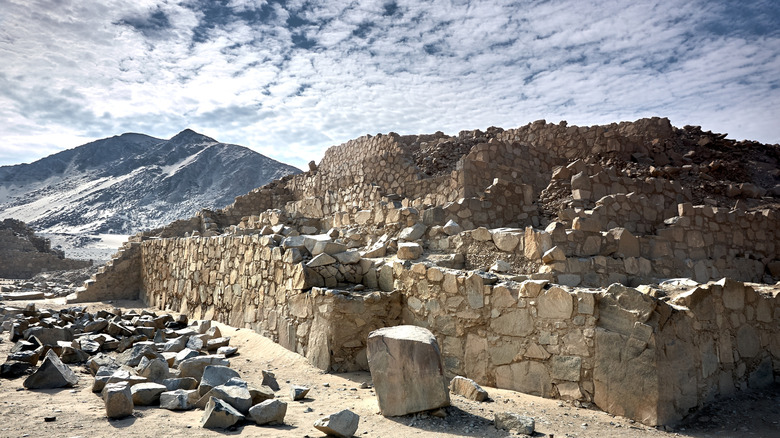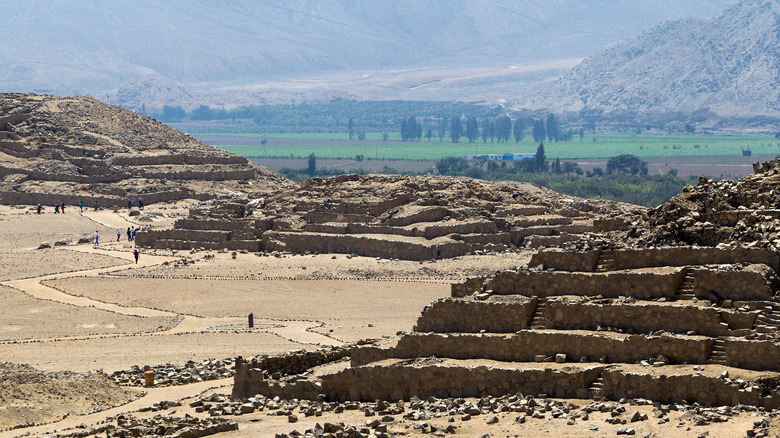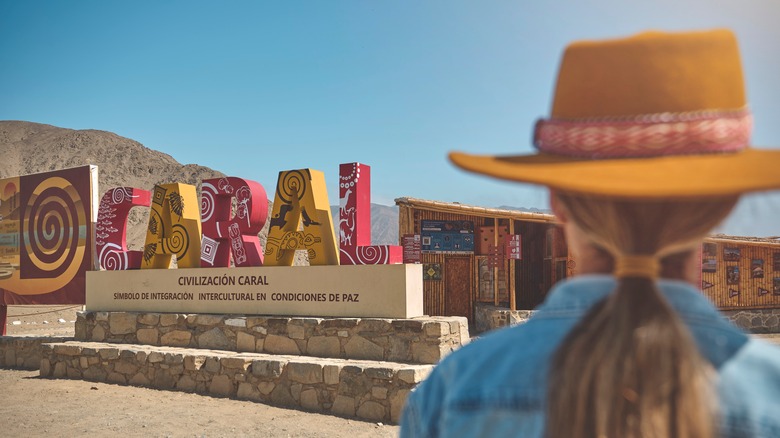One Of The World's Oldest Cities Is Peru's Less-Crowded Alternative To Machu Picchu
You know that a historic site has truly become a tourist attraction when everyone seems to have the same photo. It might be a colorful bucket list hot air balloon ride over Cappadocia; that cliff's edge vantage point at Petra in Jordan; or all those silly snaps of people pretending to hold up the Leaning Tower of Pisa. With Machu Picchu in Peru, it's the ubiquitous panorama with the Andean peaks in the background. No doubt the Incan "lost" city deserves its inclusion in the New Seven Wonders of the World, but jostling with the 1.5 million tourists who visit annually can take away a bit of the mystique. The good news for travelers who don't enjoy crowds is that Peru also has an even more ancient site which is far less visited: Caral. It's not only the first city founded in the Americas but also one of the oldest cities in the world.
Situated in the windswept desert expanses of the Supe Valley, Caral only receives around 44,000 visitors each year. Of those people, roughly 1,700 are from other countries. While it is perhaps true that these dusty ruins aren't as photogenic as Machu Picchu, what you get here is eerie solitude and a deep sense of history beneath your feet. Scattered over 150 acres, this 5,000-year-old city was one of the first hotspots of civilization on the planet, even pre-dating the majestic Pyramids of Giza. Here's what you can expect to find at this awe-inspiring UNESCO World Heritage site.
Why is Caral so deserted compared to Machu Picchu?
You may be wondering why such an important historical site attracts so few visitors, but part of the reason is that Caral is a relatively new archaeological find. While it was noted by German explorer Max Uhle in 1905, six years before Hiram Bingham re-discovered Machu Picchu, digs at Caral only began in earnest during the 1990s. Uhle unfortunately failed to realize that the site's hills were actually a series of pyramids and archaeologists of the time mistook the complex for relatively new constructions.
It would take until the 1970s before new surveys identified the pyramids, and a further two decades passed before the true historical significance of Caral was discovered. That is thanks to Peruvian archaeologist Ruth Shady Solís, who arrived in the isolated desert region in 1994. Initially paying for the dig out of her own pocket, she realized the lack of usual relics like pots and other earthenware meant that the city pre-dated the technology required to make ceramics. Painstaking work uncovering the largest pyramid, Pirámide Mayor, began in 1996, resulting in another major discovery: Carbon dating of reeds used to construct the massive edifice revealed they were 4,600 years old. This led to the conclusion that Caral was around 1,000 years older than any other settlement previously found in the Americas. Further digs have unearthed 17 more sets of pyramids across the vast site, the newest dating to around 1600 B.C. when Caral began dwindling into antiquity.
How to get to Caral and what to see
Due to its isolated location around a three-hour drive from Lima, getting to and from Caral can be a bit of an adventure. If you don't fancy driving and just want to take in the spectacular scenery of the Supe Valley along the way, bus routes are also running. Exploring the site in one day from the Peruvian capital is doable, but to make the most of your visit you may want to stay overnight. The nearby coastal city of Barranca is a good option, with plenty of available lodgings and a few decent restaurants to choose from.
Caral is open daily between 9 a.m. and 4 p.m., which should give you enough time to catch all the major highlights. The entry fee is a snip at 11 soles for adults ($2.90) and you can also hire a guide for 4 soles ($1.10), although tours are conducted in Spanish. Sometimes English language guides are present on weekends. Facilities are very basic, so it is best to bring snacks, water, and sunscreen.
The ancient city is pretty huge, so you will most likely want to concentrate on the largest pyramid complex and its surrounding structures, plazas, and excavations. You will also get a chance to inspect some of the artifacts discovered at the site, but be sure to follow the posted signage and other tips for being a considerate traveler in Peru. Don't forget to take plenty of photos and savor the peace and quiet — one day, Caral might be swarming with tourists just like Machu Picchu.


